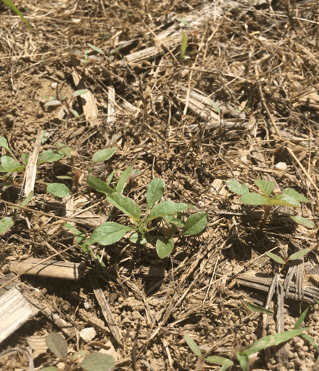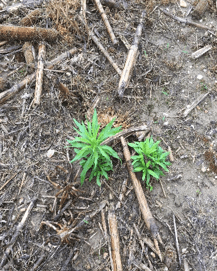Ben Beale, Principal Agriculture Agent, St. Mary’s County & Kurt Vollmer, Weed Management Extension Specialist
University of Maryland

Palmer amaranth is now germinating in fields in Southern Maryland (Fig. 1), with the largest plants around 3 inches tall. The cool spring has slowed germination and plant growth this year. At the same time last year, Palmer amaranth plants were over 10 inches tall. Hot weather is returning this week so we can expect to see plants jump in size. In soybeans, now is the critical time to control Palmer amaranth plants before the crop emerges. The optimal size for effective control of this species is 3 to 4 inches. In fields that received a burndown herbicide application in May, expect to see additional plants emerging, often before the soybean crop is planted. Paraquat (Gramoxone® or generic alternatives) is an effective burndown treatment for smaller plants provided it is applied with adequate water to achieve good spray coverage. Other options include products like 2,4-D, saflufenacil (Sharpen®), or dicamba. Each of these products have plant-back restrictions. Glyphosate, while not effective on Palmer amaranth, can still be added to control other weeds. Our recommendation for controlling Palmer amaranth continues to be starting clean, using a residual herbicide with two modes of action at planting, and using a timely postemergence application around 24 days after planting. In our trials, products with flumioxazin (Valor®) including premixes of Fierce® or Fierce XLT® or products with sulfentrazone (Authority®) including premixes Broadaxe®, Authority Elite®, and Authority MTZ® provided the most consistent control. In 2020 trials, we evaluated 15 different herbicide programs in high-pressure sites. Bottom line—preemergence products containing either sulfentrazone or flumioxazin in combination with either metribuzin, pyroxasulfone, or S-metolachlor* provided excellent control for the first three weeks. When used in combination with an effective postemergent product such as Xtendimax® or Reflex® applied 24 days after planting, Palmer amaranth was effectively controlled with 0 plants present 60 days after planting. *S-metolachlor (Dual Magnum®) or dimethenamid (Frontier® or Outlook®) cannot be tank-mixed with Valor® within 14 days of planting soybeans, unless soybeans are planted under no-till or minimum-till on wheat stubble or no-till field corn stubble.
Integrating several strategies into your weed management plan will help avoid resistance and increase control. Effective strategies include crop rotation, tillage, seed bank management, preventing seed movement, use of cover crops, narrow rows (15 inches or less) and managing the crop to promote competitive growth and quick canopy closure.
Common Ragweed and Marestail:
We have already started to receive calls about controlling ALS- and glyphosate-resistant ragweed and marestail in emerged soybeans. Unfortunately, we don’t have any of good options for control once beans are up. The only option for ALS- and glyphosate-resistant ragweed in conventional or Roundup Ready® soybean is fomesafen (Reflex® or Flexstar®).
Marestail plants are beginning to bolt in Southern Maryland (Fig. 2). Most marestail is resistant to glyphosate and ALS products. As with ragweed and Palmer, it is critical to control marestail before planting.

Unfortunately, post emergent PPO products, such as Reflex® or Cobra®, do not control marestail. In ALS- resistant populations, there are few options once beans emerge. Burndown options include glyphosate plus 2,4-D (1 qt/A), glyphosate plus dicamba or glyphosate plus Sharpen®, will effectively control glyphosate- and ALS-resistant populations when they are less than 4 inches tall. Plant back restrictions apply. Liberty® or Gramoxone® are also options for small marestail and do not have any plant back restrictions.
If you planted one of the tolerant herbicide platforms like RR2 Xtend® (dicamba, glyphosate); LibertyLink® (glufosinate); LibertyLink GT27® (glufosinate, glyphosate, HPPD); or Enlist E3® beans (2,4-D, glyphosate, glufosinate) you have an additional option for early control. With the increase in availability of different herbicide tolerance platforms, it is important that producers carefully record where each variety is planted to avoid application mistakes. Glufosinate will kill Xtend® soybeans, and dicamba will kill Enlist, LibertyLink® and Liberty Link GT® beans. A couple of reminders to increase control. Contact products such as Liberty®, Reflex® and Cobra® require good spray coverage to achieve control so use at least 15 gallons of water per acre. Liberty works best when applied in full sunlight. All POST products including Liberty®, dicamba, 2,4-D, Reflex®, Cobra®, and Ultra Blazer® are most effective when weeds are 4 inches tall or less.
More information on management of Palmer amaranth is available here: https://extension.umd.edu/sites/extension.umd.edu/files/_docs/publications/Palmer%20Amaranth%20in%20MD%20FS-1086%20%281%29.pdf
More information on management of Common Ragweed is available here: https://extension.umd.edu/learn/publications/managing-herbicide-resistant-common-ragweed
